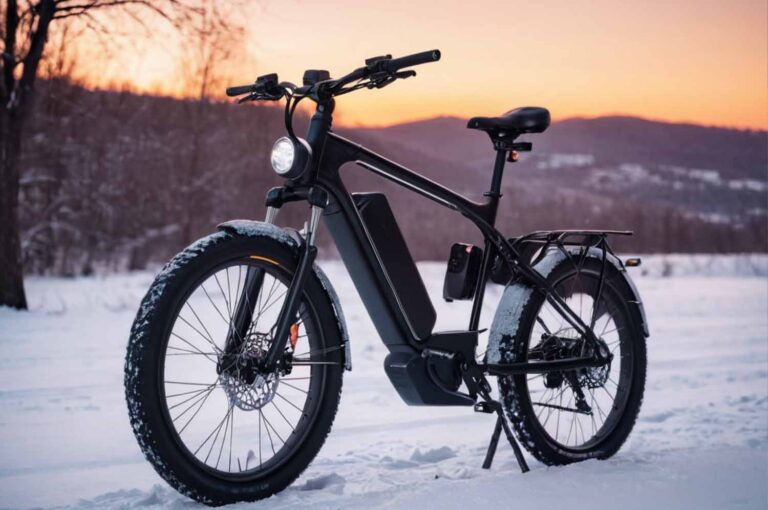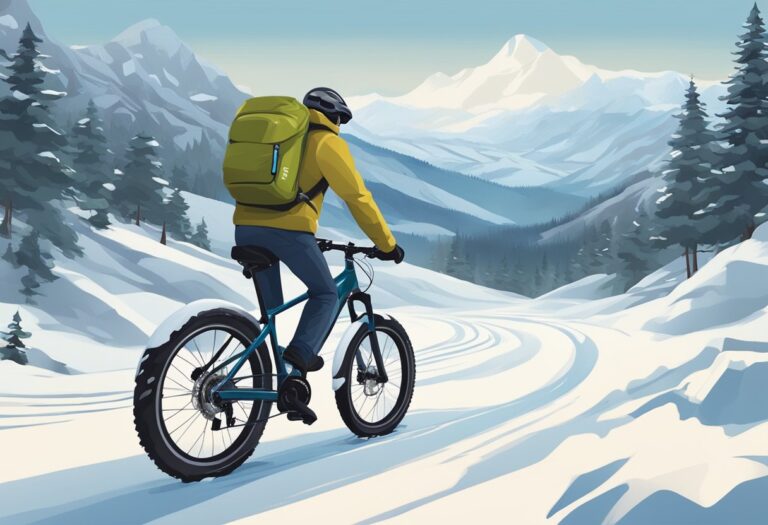Balancing Speed & Safety: Essential Tips for Winter E-Biking Delivery Pros
For those using e-bikes, the winter season demands a careful balancing act between maintaining speed to ensure timely deliveries and prioritizing safety amid potentially hazardous weather conditions.

E-bikes offer a key advantage in urban environments, allowing delivery riders to navigate traffic more efficiently than traditional vehicles.
However, navigating slippery roads, reduced visibility, and colder temperatures require a thoughtful approach to equipment and riding techniques.
Safety measures, such as proper tire selection and enhanced bike maintenance, become even more critical.
Delivery professionals must be equipped with the knowledge and tools to manage these factors effectively.
Adapting to winter conditions while operating an e-bike necessitates an understanding of how these vehicles perform in various weather scenarios and the best practices for maintaining both speed and personal safety.
This balancing act is essential not just for the wellbeing of the riders, but also for the sustainability of e-bike delivery services as a whole.
Table of Contents
Choosing the Right E-Bike for Winter
For delivery professionals, selecting an electric bike (e-bike) that can handle winter’s challenges is crucial.
Durability, control, and safety features become even more important as temperatures drop and road conditions can deteriorate.
Evaluating E-Bike Features for Cold Climates
When considering an e-bike for winter deliveries, key features should include an enclosed motor system to prevent road salt and melting snow from causing damage.
The battery performance is another critical factor, as cold weather can reduce its efficiency. Look for e-bikes with battery insulation and a power system that remains consistent in sub-zero temperatures.
A robust frame and forks made to handle extra weight and stress will also be beneficial as you navigate through snowy streets.
Ease of maintenance is also essential in cold weather to keep the e-bike in excellent condition. Consider this list of important features:
- Enclosed motor system
- Insulated battery compartment
- Low-temperature battery performance
- Durable frame and forks
- Simple maintenance requirements
Benefits of Fat Tires and Studded Tires
Fat tires and studded tires provide distinct advantages on winter terrain for e-bikes.
Fat tires offer improved grip and stability due to their wider surface area and ability to run at lower pressures, which helps to distribute the bike’s weight more evenly on snowy or slushy roads.
For icy conditions, studded tires are the optimal choice. They feature metal studs embedded in the tread, offering unparalleled traction on ice.
While fat tires are beneficial overall for winter conditions, adding studs will ensure a safer ride when you’re likely to encounter ice patches.
Here’s a comparison of tire types:
| Tire Type | Surface Compatibility | Conditions |
|---|---|---|
| Fat Tires | Snowy and slushy roads | Less stable on ice |
| Studded Tires | Icy and slick surfaces | Superior grip on ice |
Selecting the right e-bike with appropriate tires for winter delivery ensures reliability and safety, enabling delivery professionals to maintain service regardless of the weather conditions.
Battery Care and Maintenance
Impact of Cold Weather on Battery Performance
Cold weather can significantly reduce battery capacity and affect overall battery performance. Lithium-ion batteries, which are commonly used in e-bikes, are known to experience a drop in available capacity when the temperature falls.
For instance, a decrease from 25°C to -15°C may result in up to a 23% reduction in charge. To mitigate the effects of cold on an e-bike battery, one should be mindful of the temperature thresholds and the ways it impacts energy output.
Best Practices for Battery Storage and Charging
Maintenance and Charging Tips
- Always store the battery in a cool, dry place, avoiding extreme temperatures.
- Charge the battery at room temperature (20°C – 25°C) to ensure optimum charge intake.
Spare Battery Care
- Have a spare battery and keep it charged and conditioned, as cold weather aside, frequent use requires regular rotation.
Practicing diligent battery care is a proactive step towards ensuring the longevity and reliability of an e-bike.
Regular maintenance checks, coupled with proper storage and charging disciplines, are key to sustaining peak battery performance.
Appropriate Winter Clothing for E-Bikers

Successful winter e-biking hinges on layering clothing to trap heat and wick away sweat. The base layer should be composed of moisture-wicking materials like merino wool or synthetic fibers, keeping the skin dry.
Over the base layer, riders should add an insulating middle layer, typically made from fleece or a lightweight, synthetic down substitute, which offers warmth.
The outermost layer must be both windproof and waterproof to protect against frosty gusts and precipitation.
Example of an E-Biker’s Layering System:
- Base Layer: Moisture-wicking long-sleeve shirt and leggings
- Mid Layer: Insulated jacket and pants
- Outer Layer: Breathable, waterproof cycling jacket and trousers
Essential Winter Cycling Gear
Proper winter gear extends beyond clothing. Delivery e-bikers should always wear a helmet, possibly with a thermal liner for additional warmth.
Gloves are critical, and many riders prefer specially designed cycling gloves that offer both insulation and enough dexterity to handle the bike’s controls. To keep feet warm, one could wear thermal socks paired with waterproof boots or shoe covers.
For extreme cold and biting winds, a balaclava or scarf can protect the face, and goggles shield the eyes from glare and freezing air.
Adding a final layer to this ensemble ensures that e-bikers are dressed appropriately for winter’s harsh conditions.
Key Winter Cycling Accessories:
- Head and Neck: Helmet, Balaclava/Scarf
- Hands: Insulated, Waterproof Cycling Gloves
- Feet: Thermal Socks, Waterproof Footwear
Choosing the right clothing and accessories for winter e-biking is essential for those who continue to make deliveries despite the drop in temperature.
The aim is to be well-insulated, dry, and safe as they navigate the challenging winter weather conditions.
Safe Riding Techniques in Winter Conditions
In snowy and icy conditions, maintaining traction is crucial. Riders should reduce their speed to enhance control, giving themselves ample time to react to unforeseen obstacles.
A wider tire tread can improve grip, and specific tires designed for cold weather may be beneficial. The riding style must be adjusted — sharp turns and sudden movements can lead to a loss of control, so smooth, gradual maneuvers are recommended.
Braking distances increase on icy roads; therefore, delivery professionals should plan stops well in advance and use brakes gently to prevent skidding.
- Key Adjustments for Riding Style:
- Speed: Substantially reduced.
- Turning: Gradual and smooth.
- Braking: Early and gentle.
Navigating Slippery Surfaces and Reduced Visibility
Reduced visibility due to snow, sleet, or fog requires additional caution. Riders should ensure they are visible to others by using lights and reflective materials.
When confronting slippery conditions, it is imperative to keep the bike as upright as possible to maintain maximum contact with the ground.
In the event of crossing over ice or slick spots, avoiding sudden changes in speed or direction is essential to stay safe.
For optimal control, the body should remain relaxed, and weight should be distributed evenly. Predictive riding, anticipating the moves of others on the road, can help avoid abrupt and potentially dangerous maneuvers.
- Techniques for Enhanced Safety:
- Visibility: Utilize lights and reflective gear.
- Balance: Keep the bike upright and weight even.
- Predictive Riding: Anticipate potential hazards and movements of others.
E-Bike Preparation and Pre-Ride Checklist

Adjusting Tire Pressure and Tread for Winter Terrain
For winter conditions, electric bike riders should adjust their tire pressure to ensure better traction on snowy or icy surfaces.
Lower tire pressure can provide a larger contact area between the tire and the road. However, one must avoid reducing the pressure too much to prevent pinch flats.
- Recommended Tire Pressure for Snow:
- Road: Slightly below the usual range.
- Off-Road: 5-10 PSI lower than dry conditions.
Tire treads should be examined for signs of wear and replaced if necessary. Deep treads are essential for gripping slippery terrain effectively.
- Tire Tread Check:
- Condition: Look for cracks, cuts, and tears.
- Traction: Ensure the tread depth is sufficient for snow.
Routine Checks for Lighting and Braking Systems
Winter rides demand well-functioning front and rear lights due to shorter daylight hours and poorer visibility. E-bike riders must perform routine checks to confirm that lights are bright and visible from a distance.
- Light Inspection:
- Front lights: Should illuminate the path ahead clearly.
- Rear lights: Must be visible to traffic following behind.
Brakes are fundamental to safety, especially when roads are slick. Brake performance should be checked before each ride.
Brake pads must be free of debris and not worn down. A simple wipe down can remove any dirt or grime that might impair braking efficiency.
- Brake System Check:
- Front brakes: Inspect for even wear and replace if thin.
- Rear brakes: Clean regularly for consistent performance.
Overcoming Winter Elements: Snow, Salt, and Slush

Protecting Your E-Bike’s Components from Corrosion
Snow and slush carry moisture that can lead to rust, while salt can cause rapid deterioration of metal parts. Specifically, the chain and frame are at high risk.
Delivery professionals should consider applying a protective coat to the frame and using chain guards.
Regular inspection of electrical connections is crucial, as corrosion here can lead to electrical failures. Silicone sprays or protective gels are recommended for shielding these connections from moisture.
Effective Cleaning and Lubrication Practices
After navigating through snow, salt, and slush, cleaning your e-bike is a vital step. It’s not only about aesthetics but preventing the buildup of corrosive materials.
Use a mild detergent and avoid high-pressure hoses that could force water into sensitive areas. Once clean, drying the e-bike thoroughly is essential to remove any residual moisture.
Lubrication is the next critical step, particularly for the chain and gear components. Use lubricants that are specifically designed for wet conditions. Here is a simple guide for maintenance:
- Cleaning: After each ride through wet conditions.
- Lubrication Frequency: Every 100-200 miles or if the e-bike sounds unusually noisy.
- Winterizing Your E-Bike
- Inspect and clean electrical connections.
- Apply lubricant liberally to the chain.
- Use fenders to reduce direct exposure to slush and salt.
Regular maintenance following these methods as part of winterizing your e-bike will not only extend the life of the vehicle but also ensure consistent performance and safety during the challenging winter months.
Enhancing Visibility and Safety on the Road
Visibility on the road is severely compromised in winter due to shorter days and inclement weather.
Delivery professionals must equip their e-bikes with bright lights that are visible from a distance, ensuring they are seen by motorists, pedestrians, and other cyclists.
Front and rear lights, along with additional wheel and frame lights, can significantly enhance visibility.
Reflective clothing plays a critical role in safety after dark. This includes reflective jackets, pants, gloves, and helmet strips.
Reflective gear ensures that delivery professionals are noticeable from all angles, especially when caught in the glare of vehicle headlights.
- Battery Life of E-Bike Lights in Winter
- Always use lights with long-lasting batteries or a dynamo system that charges while pedaling.
- Recommended Reflective Clothing for Maximum Visibility
- Vest: High-visibility with reflective strips
- Pants: Reflective bands or piping
- Gloves: Reflective material on back
- Helmet: Reflective stickers or built-in lights
Safety Precautions for Interacting With Traffic
When moving amidst traffic, a slow and steady approach aids in safe maneuvering. It’s imperative that delivery professionals maintain a consistent speed that allows for quick reaction times.
Signaling intentions clearly and decisively informs other road users of their movements, preventing collisions.
To stay warm and safe, riders should consider layering clothing to maintain body heat while retaining mobility. Winter weather can change rapidly, and being prepared for varying conditions ensures a delivery professional can focus on road safety.
- Hand Signals and Interaction With Traffic
- Left Turn: Fully extend the left arm out sideways
- Right Turn: Fully extend the right arm out sideways or raise the left arm up at a right angle with hand flat
- Stop: Extend the left arm downwards with the palm facing back
Adhering to these guidelines ensures heightened visibility and enhances overall road safety for e-bike delivery professionals, especially during the challenging winter months.
Cold Weather Cycling Accessories
E-bike delivery professionals face unique challenges when temperatures drop. The right cold weather cycling accessories are crucial for maintaining comfort and safety during winter deliveries.
Selecting Accessories for Comfort and Protection
When temperatures fall, the right accessories keep a cyclist’s extremities warm and protected. Gloves and goggles are essential; they shield the hands and eyes from the biting cold and improve visibility in adverse weather conditions.
Gloves should be insulated yet allow for dexterity to handle the bike controls and packages. Goggles or glasses with anti-fog properties help maintain clear vision.
Bar Mitts, Helmet Covers, and Winter Cycling Shoes
To further winterize an e-bike setup, bar mitts, helmet covers, and winter cycling shoes become valuable:
- Bar Mitts: These attach directly to the handlebars, creating a shield against wind and snow, allowing riders to wear lighter gloves for better dexterity.
- Helmet Covers: A cover helps retain heat and keeps the rider’s head dry, as a significant amount of body heat is lost through the head.
- Winter Cycling Shoes: Insulated and waterproof shoes are necessary to keep the feet warm and dry, crucial for control and comfort on winter rides.
| Item | Purpose | Notes |
|---|---|---|
| Insulated Gloves | Warmth and Grip | Must not compromise on control dexterity |
| Anti-fog Goggles | Clear Vision | Vital for safe navigation |
| Bar Mitts | Extremity Protection | Allows use of lighter gloves |
| Helmet Covers | Heat Retention | Water-resistant to safeguard against precipitation |
| Winter Cycling Shoes | Keep Feet Dry and Warm | Waterproof and insulated for maximum comfort |
Layering is a key concept in winter cycling apparel. Riders should layer their clothing to trap body heat and add a waterproof outer layer to stay dry.
This approach allows them to adjust insulation by adding or removing layers as needed. Ensuring one stays warm and safe, while being able to move freely, is essential for efficiency and preventing accidents on icy roads.
Strategies for Efficient E-Bike Delivery
For delivery professionals utilizing e-bikes during the winter months, efficiency is paramount. Balancing speed and safety requires precise strategies to ensure timely deliveries without compromising control and stability.
Optimizing Routes for Safety and Timeliness
To maintain high performance during deliveries, professionals should prioritize route optimization that factors in winter road conditions. They can utilize GPS and mapping software to identify paths that are cleared of snow and ice, thus enhancing safety and speed.
Additionally, incorporating real-time traffic data can help avoid congested areas that could slow down delivery times.
- Route Planning Tools: GPS applications
- Criteria for Route Selection:
- Road condition reports
- Traffic flow patterns
- Historical data on winter incidents
Managing Workload and Energy Use
Delivery professionals must also manage their workload and their e-bike’s energy use to sustain performance throughout the day. They should:
- Start with a fully charged battery: Cold temperatures can reduce battery efficiency, so beginning the day with a full charge is crucial.
- Plan for shorter routes: This conserves battery life and ensures the e-bike retains enough power for stability and control in potentially hazardous conditions.
- Schedule regular breaks: These allow for necessary rest and e-bike inspections to maintain safety and functionality.
- Battery Management:
- Initial Charge: 100%
- Usage per Delivery: Aim to use less than 15% per trip
- Recharge Frequency: After every 3-4 deliveries or as needed based on the battery performance indicators



